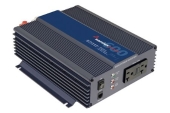posted 3 years ago
These computer UPS units are underneath or near everyone's computer desk these days, and cost anywhere from $50 or so, on up to $hundreds. They really help on riding out most blackouts/brownouts and other power fluctuations. Most folks use them where they don't want the electronics devices to fail right in the middle of use, so the UPS is inserted between the devices and the power source.
They usually have 6 AC plugs (120v in the US), an internal 12v battery, and some electronics; when they fail, it's most often with a dead battery. If you pick some up at a flea market, they'll most likely have only a dead battery in them, and can be easily brought back to life.
Tools: phillips-head screwdriver, wire cutters, CTEK 12v 4.3amp battery charger (many others); possibly a "specialty bit" (for weird screws).
Repair:
0. safety: always unplug unit from wall; wear rubber gloves & safety glasses
1. remove cover to battery area; pull the red & black wires off the battery; recharge the battery outside with the CTEK (if it says battery is dead, it's dead), discard/replace.
- replacement battery off the internet: just google 12v/7ah (or whatever the numbers are on your battery), and you'll find lots of hits.
- hook up the new battery: red wire (+) to red position on battery; black wire (-) to black position on battery; close up the case, power on.
- If unit works with replacement battery, then another few years of life.
2. if loose wires or smoked components, then decide if fixable, or if you'll recycle the whole thing; sometimes the unit really is dead, but the 12v battery is still good (CTEK will help determine this) ... save for other projects.
Recycle:
0. safety: always unplug unit from wall; wear rubber gloves & safety glasses
1. remove all external screws, expose innards, keep removing all screws until everything comes out; wire cutter to cut loose any soldered wires
2. battery: test with CTEK; if failed, then to battery recycling; if good, save for another project (many devices use 12v batteries, of varying Ah ratings)
3. wires: save all these to a container, with or without connectors on them; they are in various AWG sizes, and you never know when they'll come in handy.
4. screws: save all these to a container; saves purchasing those silly 4 screws in a bag for $5.
5. electronics (boards): save these to a box for the day when you can desolder all of them outside with a heat gun, and replenish your electronics parts bins; or, send them to an electronics recycle facility, or a maker club.
6. plastics: if numbered (1 thru 5, or similar), send them to the appropriate plastics recycle bin. If not numbered (old plastic), just send to the dump.
With practice on taking things apart when they seem dead, you'll get really good at repairing things around the homestead. If it's dead and needs recycling, you'll get really fast at it, and you'll end up with recycled parts (saving money) and/or reduced trash loads to your local waste (dump) facility.
Repair/Recycle success rate:
- 1/3 of the time, I see something I can fix (loose wire, fuse, etc.); saves a complete new purchase. Sometimes cleaning it out fixes it, as dust or critter parts can short something. In the case of these UPS's, replacing the battery works almost 75% of the time.
- 1/3 of the time, I see the smoking gun of failure (a smoked component on an electronic board with charring around it, etc.)
- final 1/3 of the time, I cannot determine the fault at all, so I know to write this unit off and finish recycling it.
Hope this helps ...









